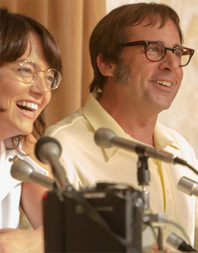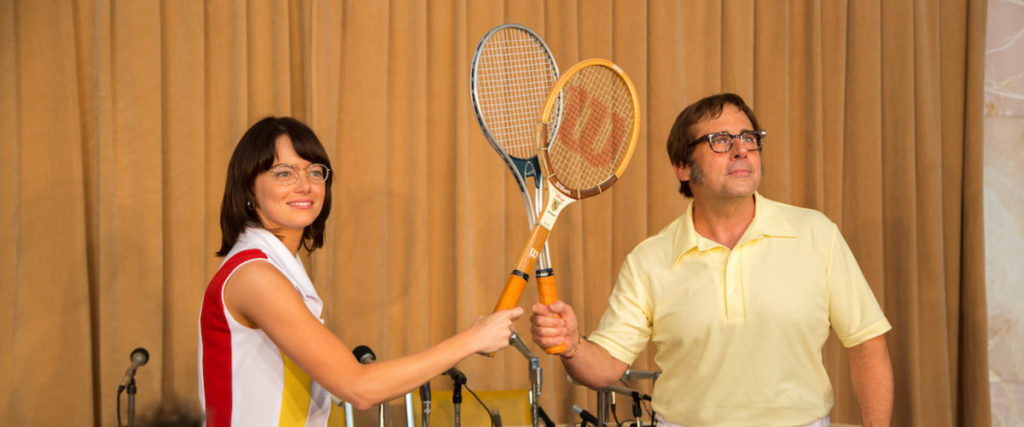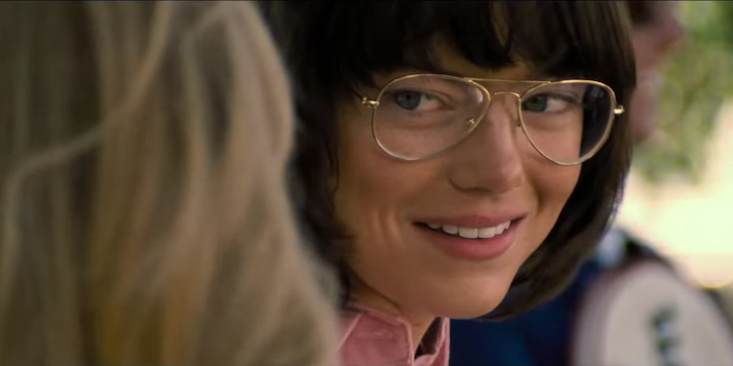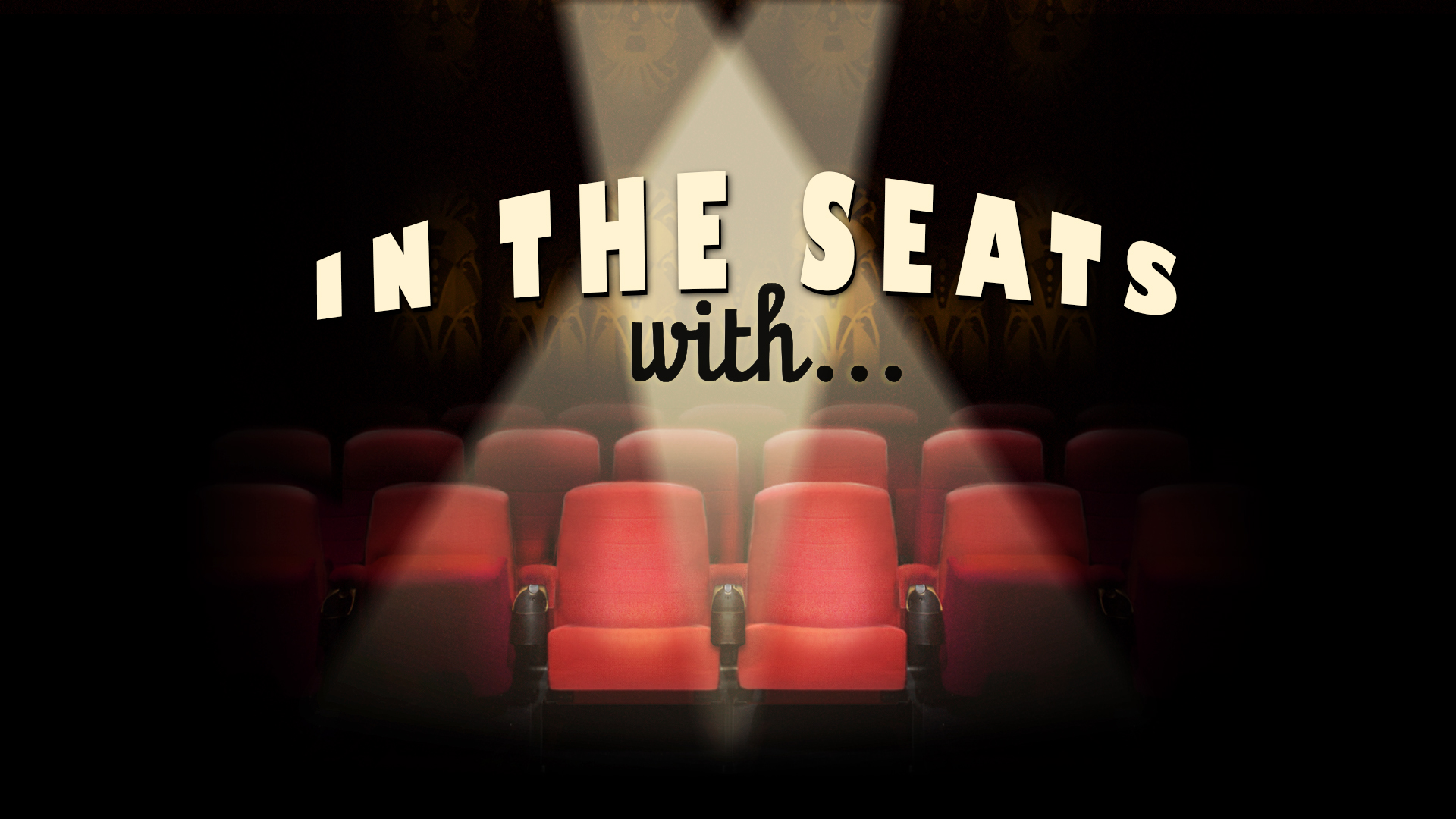
History isn’t always about foot soldiers fighting wars in countries that are far away from us. Sometimes, it’s battles a few people fight in smaller fields. The real Battle of the Sexes is a tennis match between Billie Jean King and Bobby Riggs in 1973. It was historical. Surely there were more ‘important’ things happening then. In the film version, rivaling tennis player Margaret Court (Jessica McNamee) says that ‘it’s just a tennis match’. But this event was in the American consciousness. King and Riggs’ physical battle ground found itself packed with 30,000 people. And 90 million people watched them on TV. Which is part of King and her cinematic counterpart’s (Emma Stone) argument. That audiences want to watch women play tennis and that prize money for winning women’s tournaments should reflect audience demand.
The film shows King and Riggs (Steve Carell) differences, so I’ll talk about those first. Think of their struggles as a tournament, both leads having to face their own troubles before facing each other. In real life King has her share of losses but her victories outweigh those. Winning three grand slams or so a year isn’t an easy thing to maintain. Players like Court are nipping at her heels. Again, the prize money in some American tournaments felt too little for her and all women. So she and Gladys Heldman (Sarah Silverman) partnered with eight other players formed the Virginia Slims Tour. The movie doesn’t clarify that King and crew formed that tour in 1970. Although it’s easy to look those things up after watching the film. King balances running the tournament and her marriage to a Larry King (Austin Stowell).
There’s this delicious irony to King and the female characters striking out in their work environments. Larry and Riggs, on the other hand, find themselves stuck in more domestic places. The first shot that we see of King is an intense yet cool close-up of her in a match. Riggs, a former world champion, might as well be in prison, finding himself in a boring office job in Manhattan. He’s in his 50’s when the film begins telling his story. The only way he gets to play tennis is with his country club buddies later at night. He hears the news about how much money King gets outside tournaments. And he believes he deserves more and decides to go back as a professional player and challenge her.
Which is one of the things they have in common. Both believe they deserve more money that what their respective fields give them. Both find themselves stuck in marriages to wonderful people who aren’t perfect fits for them. Yes, King has her marriage to Larry. But she finds herself in love with a hairdresser named Marilyn Bennett (Andrea Riseborough). Riggs, on the other hand, has his married to Priscilla Whelan (Elisabeth Shue). Despite of Riggs’ humourous chest beating bravado, has more power in the relationship than he does. She kicks him out of her house when she discovers his gambling habit. And of course he deals with this setback with more gambling. That’s if you count his challenges to both Court and King in these tennis matches as gambling.
Riggs’ idea was to challenge King, but Court won more titles in 1973 than King did. Riggs preferred to beat the best of her gender than to defeat a high profile player who was ‘waning’. But Riggs lobbing techniques spooks Court, beating her in a decisive game. Riggs, gloating in his victory, challenges any woman to beat him for a six figure prize money. He says ‘any woman’ although the characters in the film assume that King was the target of that challenge. King, a feminist trailblazer, had as much to prove in a victory. Much more so than Riggs does in disproving the female mettle against his techniques. So King calls Larry to arrange the match, making that call at midnight, as Riggs would have.
The film shows teamwork – support systems are prominent in Valerie Ferris and Jonathan Dayton’s films. Their first film Little Miss Sunshine shows a mix of comic and dramatic elements. Both work to show a dysfunctional family pulling through to make their little girl’s dreams come true. Their next film, Ruby Sparks, is more insular. There, a man writes up a dream girl into life thinking she would be of great use to him. Here in Battle of the Sexes, the supporting characters propping up the leads means more in other films. Sometimes, these systems work, showing a variety of personalities reacting to the events shaking up their lives. And in other times, unfortunately, they undermine the film’s message by softening its effects.
As it does, this cooperative ethos works well with the women. Silverman’s portrayal of the wise-cracking Heldman and Riseborough’s scene-stealing work as the free loving Bennett. Natalie Morales also plays tennis player Rosie Casalas. She is loyal to King even at tough times when the latter was losing. These women have different versions of girl power. These qualities complement Stone, who, usually a comic actress, infuses a soft, regal air in her portrayal of King. Simon Beaufoy’s script based on of real life events make room for King to clap back at Riggs’ sexist jokes. But the women and some men around her do enough of the lifting so King can focus on the game.
On the other hand, each depiction of misogyny as we see in the film is a downplaying of that prejudice. We see Riggs as a good father under his rich, powerful wife. So it’s as if anything he can do after that is moot. His friend Jack Cramer (Bill Pullman) and the United States Lawn Tennis Association, however, do the sexist talking for him. Cramer’s first crack in sexism make it more real than if Riggs did a cartoony version of the same opinions. Sure, nobody takes ‘women belong in the kitchen’ jokes seriously, and I say that as a cis male. The film even argues that Riggs uses these quips as part of his persona. But misogyny is misogyny. And making it cute to make both Riggs and Carell more sympathetic is one of the film’s flubs.
I previously mentioned how different the film portrays King and Riggs in the visual sense. King gets the close-ups the ironically express her freedom and progress in the new stages of her life. On the other hand, the film shows Riggs with constraints. He’s in these long shots, either within the concrete jungle or his costumes while playing tennis. But both story and visuals converge or the two of them. Eventually we see both in their locker rooms after the match. Both don’t finding happiness in either result that the match gives them. And herein lies the tragedy that Ferris and Dayton chooses to show us. That their circumstances separate them so much that they never have that moment to realize what they have in common.
- Release Date: 9/22/2017



